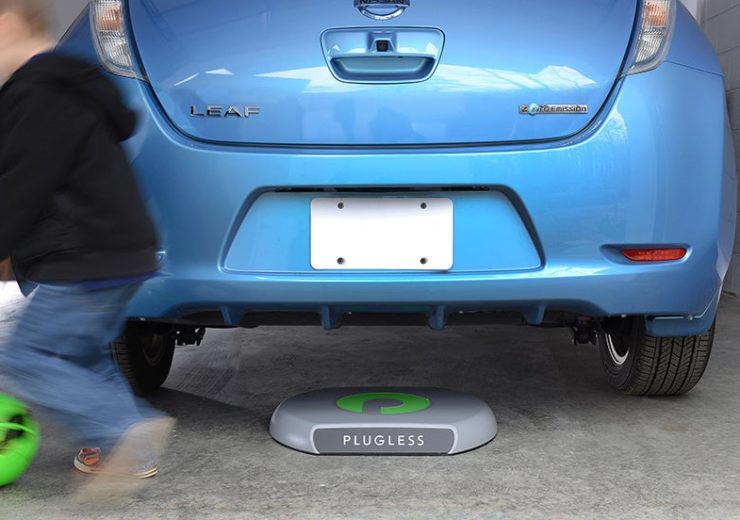A new commitment to install wireless charging infrastructure for electric vehicles could provide a boost to dreams of creating smart cities

The Nissan Leaf electric car can be charged wirelessly (Credit: Nissan)
The UK government this week announced it will pump £40m into improving the infrastructure for wireless charging of electric vehicles in a bid to arrest a slump in hybrid car sales. Dan Bladen, CEO and co-founder of smart wireless charging company Chargifi, argues why power is the most important part of future smart, sustainable cities
One year ago, the UK government announced its Road to Zero strategy, a set of new measures to clean up road transport and lead the world in developing, manufacturing and using zero-emission road vehicles.
No one can deny the steps the UK has taken since then – a 60% increase in battery electric vehicle registrations, mainstream manufacturers starting to commit to all-electric (BMW’s announcement of the Mini Cooper SE could not have come soon enough) and movements from the UK’s major cities to introduce clean air zones.
Despite consumer uptake of electric vehicles, range anxiety – in most part sparked by the lack of available and operational fast charge infrastructure – is still one of the biggest barriers to the transition.
The UK government has so far failed to outline a cohesive national strategy for electric vehicle charging, until now.

On 9 July, the government made a commitment of £37m into British engineering to transform electric charge-point infrastructure, including the creation of wireless charging innovations – the announcement of which is more than a welcome sight.
Wireless charging technology is developing quickly and it will only be a few years until it becomes common-place across society.
As such, the government has recognised the need to invest in this pioneering technology, which is so critical to the world’s fully electric future.
Here’s why wireless charging will play such a key role.
Wireless charging is scalable
Wireless charging should become the bedrock of the future smart city and essential for the transformation of global mobility.
It’s a scalable solution and the government’s investment into companies like Char.gy and Sprint Power to deploy wireless charging technology – without the need for trailing cables – is an important step in ensuring a reliable charging infrastructure for electric vehicles will be available to the masses.
It’s a commitment that will, no doubt, encourage more people to join the low-emission movement.
The future of wireless charging for electric vehicles
Among the commitments made by the UK government this week is the development of new solar forecourts, wireless charging and a project to deliver cost-effective and wide-spread charging.
Of all the investments announced, these are undoubtedly the most important.
Car-sharing is exploding – even as early as 2026, it’s predicted more rides will occur with ride-sharing than privately owned vehicles.
By 2044, it is predicted that car ownership in urban areas will collapse and ride-hailed connected autonomous vehicles (CAVs) will be commonplace – I am personally predicting that it will even be illegal to drive manually on certain roads.
Which is why administering wireless charging solutions will be critical to keeping our future transport systems on the move.
This type of charging infrastructure will replace the human need to plug-in, allowing for maximum uptime and efficiency of public transportation, business-critical and emergency service vehicles.
Ultimately, wireless charging will pave the way for mass adoption of autonomous vehicles that, crudely, don’t have arms to plug themselves.
Wireless charging for electric vehicles will be part of foundations for a truly intelligent smart city
Over the next 25 years, new technologies like augmented reality and ambient computing will transform the urban experience from one that is “on-demand” to one that is “orchestrated”.
Let’s take public transport as an example. The smart city and the individual’s data contributing to that city will provide the “input” to the system in order for the vehicle to arrive automatically, at the most convenient time and to the right location, all without the user even having to “order” the transport.

Power sits as the bedrock of the hierarchy of needs – without power, nothing happens.
Smart wireless charging will be the foundation of not only ensuring a transport system is fully charged and able to reach its users but enabling vast data capture for which the IoT – in bringing together billions of connected smart services and devices – so critically relies.
Smart charging capability will allow public and private sector organisations to harness the power of real-time analytics to deliver an integrated view of a city’s infrastructure – crucial for local authorities and transport operators for whom the sharing of data is fundamental to understanding passengers needs and requirements for their services.
Only when systems work together to form a “shared intuition” like this, will smart cities be definitively “smart”.
The mission to a green future
The government’s pledge to improve the UK’s charging infrastructure is refreshing and it is a step in the right direction towards a fully electric future.
However, it’s a pot that will only stretch so far and we must see continued commitment to new technologies and collaboration among innovators, planners and government bodies if the UK is to lead on the race towards a green future.


